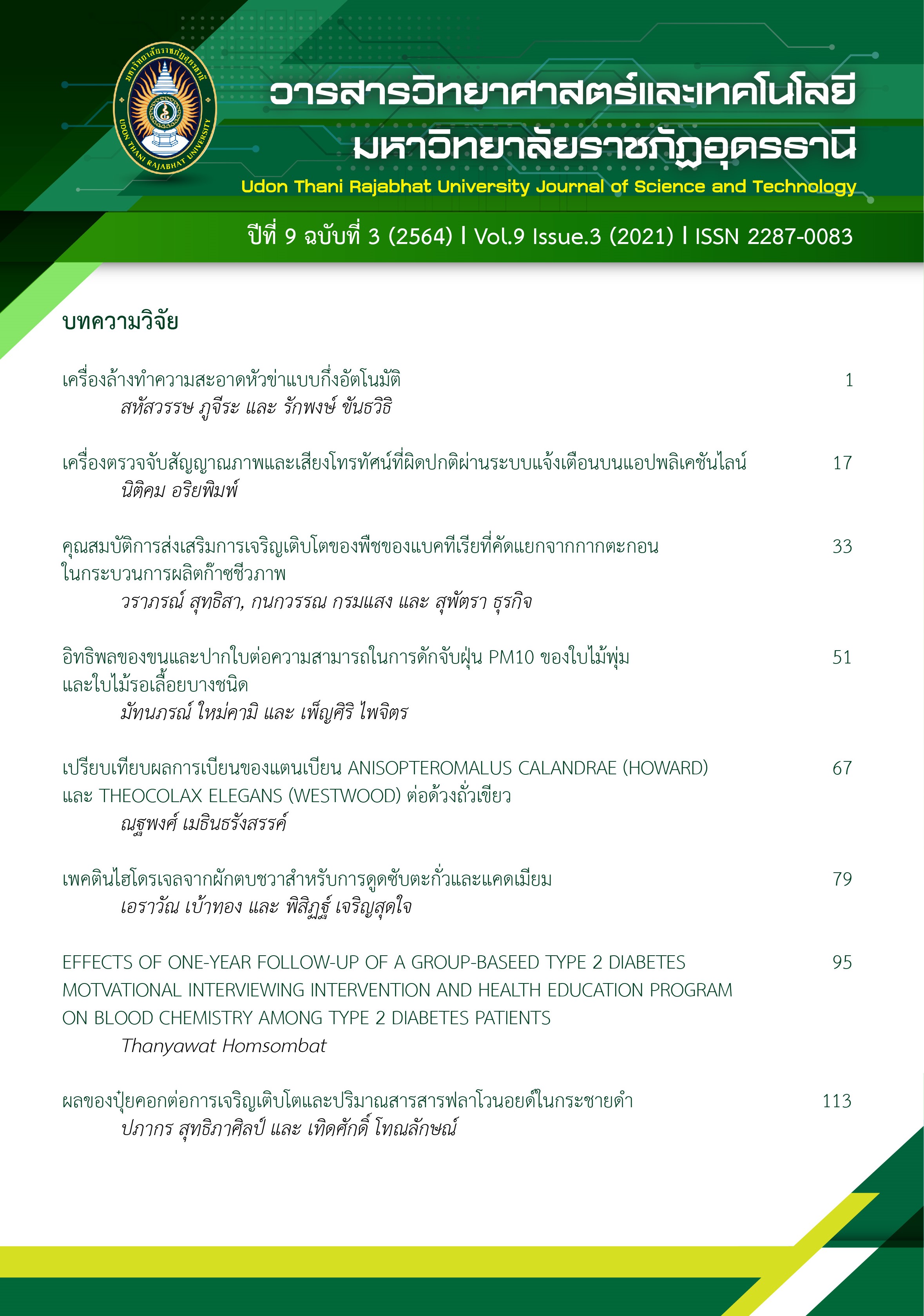THE INFLUENCE OF TRICHOME AND STOMATA ON PM10 CAPTURE CAPABILITY OF SOME TYPE OF SHRUB AND SCANDENT LEAVES
Main Article Content
Abstract
Particulate matter (PM) has been a problem that has affected and hazard to human health. Previous studies reported that plant leaves were capable of dust capture, especially leaves with uneven surfaces. Therefore, four species of plants with hairy leaves, consisting of 2 shrubs (Fukien Tea and Sandpaper vine) and 2 scandents (Butterfly bush and Blue trumpet), were investigated leaf shape, leaf size, trichome, stomata and the efficiency of dust powder capture particles smaller than 10 microns (PM10). The research revealed that the Butterfly bush had dust powder particles remaining on the leaf the most according to the widest leaf and longest stomata. The Blue trumpet had the most leaf area. But the efficiency of powder capture particles was less than Butterfly bush due to the lower trichome cell density on the ventral side. However, the Sandpaper vine had the highest trichome cell density but the trichome cells and stomata were short. Therefore, the remaining dust powder particles on the leaf blade were quite a few. Fukien tea was the least effective in capturing dust because of its small leaf size and less dense trichome cells. Considering the correlation of leaf width and stomata length, there was a significantly greater positive correlation than leaf area and both surfaces of leaf trichome on PM10 dust capture efficiency which showed that leaf shape, stomata length, trichome length, trichome density and the density of the stomata affected the dust particulate capture efficiency.
Article Details
References
กรมควบคุมมลพิษ. (2561). โครงการศึกษาแหล่งกำเนิดและแนวทางการจัดการฝุ่นละอองขนาดไม่เกิน 2.5 ไมครอน ในพื้นที่กรุงเทพและปริมณฑล. กรุงเทพฯ: กองจัดการคุณภาพอากาศและเสียง กรมควบคุมมลพิษ กระทรวงทรัพยากรธรรมชาติและสิ่งแวดล้อม.
กรมอนามัย และกรมควบคุมโรค กระทรวงสาธารณสุข. (2558). แนวทางการเฝ้าระวังพื้นที่เสี่ยงจากมลพิษทางอากาศ กรณีฝุ่นละอองขนาดเล็ก. กรุงเทพฯ: โรงพิมพ์ชุมนุมสหกรณ์การเกษตรแห่งประเทศไทย
กลุ่มเฝ้าระวังฝุ่น จุฬาลงกรณ์มหาวิทยาลัย. (2562). เรียนรู้ อยู่กับฝุ่น PM2.5. กรุงเทพฯ: จุฬาลงกรณ์มหาวิทยาลัย.
เกษม จันทร์แก้ว. (2541). เทคโนโลยีสิ่งแวดล้อม. กรุงเทพฯ: โครงการสหวิทยาการบัณฑิตศึกษา สาขาวิทยาศาสตร์สิ่งแวดล้อม คณะวิทยาศาสตร์ มหาวิทยาลัยเกษตรศาสตร์.
จิดาภา พรหมสิงห,์ อนิษฐาน ศรีนวล และ วิโรจน์ เกษรบัว. (2559). กายวิภาคศาสตร์เนื้อเยื่อชั้นผิวใบของพืชวงศ์มะขามป้อม (Phyllanthaceae) บางชนิดในประเทศไทย. วารสารวิทยาศาสตร์และเทคโนโลยีมหาวิทยาลัยอุบลราชธานี, 18(3), 87-87.
ปิยรัษฎ์ ปริญญาพงษ์ เจริญทรัพย์. (2558). พวงคราม. จุลสาร สวนพฤกษศาสตร์โรงเรียน, 20(2): 6
พาสินี สุนากร, องอาจ ถาพรภาษี และ พัชริยา บุญกอแก้ว. (2559). การศึกษาเปรียบเทียบความสามารถในการจับฝุ่นละอองของพรรณไม้เลื้อย. สิ่งแวดล้อมสรรค์สร้างวินิจฉัย, 15(2), 175-186.
นิพนธ์ ตังคณานุรักษ์ และ คณิตา ตังคณานุรักษ์. (2552). เคมีบรรยากาศ. กรุงเทพฯ: มหาวิทยาลัยเกษตรศาสตร์.
ราชันย์ ภู่มา. (2559). สารานุกรมพืชในประเทศไทย (ฉบับย่อ) เฉลิมพระเกียรติสมเด็จพระเทพรัตนราชสุดาฯ สยามบรมราชกุมารี ทรงเจริญพระชนมายุ 60 พรรษา. กรุงเทพฯ: สำนักงานหอพรรณไม้ สำนักวิจัยการอนุรักษ์ป่าไม้และพันธุ์พืช กรมอุทยานแห่งชาติ สัตว์ป่า และพันธุ์พืช กระทรวงทรัพยากรธรรมชาติและสิ่งแวดล้อม.
ราชันย์ ภู่มา, ปิยชาติ ไตรสารศรี, จิรพรรณ โสภี, นัยนา เทศนา, มานพ ผู้พัฒน์ และ โสมนัสสา ธนิกกูล. (2563). ต้นไม้ลดฝุ่น PM2.5. กรุงเทพฯ: สำนักวิจัยการอนุรักษ์ป่าไม้และพันธุ์พืช กรมอุทยานแห่งชาติสัตว์ป่า และพันธุ์พืช กระทรวงทรัพยากร ธรรมชาติและสิ่งแวดล้อม.
วงษ์จันทร์ วงษ์แก้ว. (2535). หลักสรีรวิทยาของพืช. กรุงเทพฯ: ฟันนี่พับลิชชิ่ง.
วรมน แสนชมภู. (2559). รูปแบบและวัสดุที่ใช้งานก่อสร้างรั้วบ้านพักอาศัย : กรณีศึกษาเขตจตุจักร. (วิทยานิพนธ์วิทยาศาสตรมหาบัณฑิต จุฬาลงกรณ์มหาวิทยาลัย).
วริศชนม์ นิลนนท์, กุลพร พุทธมี และ จิรพร สวัสดิการ. (2560). การพัฒนาการผลิตแป้งฟลาวร์และสตาร์ชจากเมล็ดทุเรียน และ การประยุกต์ใช้ในผลิตภัณฑ์อาหาร. คณะเทคโนโลยีการเกษตร มหาวิทยาลัยราชภัฏราไพพรรณี
Esposito, F., Memoli, V., Panico, S. C., Di Natale, G., Trifuoggi, M., Giarra, A., & Maisto, G. (2020). Leaf traits of Quercus ilex L. affect particulate matter accumulation. Urban Forestry & Urban Greening, 54, 126780.
Kwak, M. J., Lee, J. K., Park, S., Kim, H., Lim, Y. J., Lee, K. A., Son, J., Oh, C. Y., Kim, I., & Woo, S. Y. (2020). Surface-based analysis of leaf microstructures for adsorbing and retaining capability of airborne particulate matter in ten woody species. Forests, 11(9), 1-20.
Leonard, R. J., McArthur, C., & Hochuli, D. F. (2016). Particulate matter deposition on roadside plants and the importance of leaf trait combinations. Urban Forestry & Urban Greening, 20, 249-253.
Liang, D., Ma, C., Wang, Y. Q., Wang, Y. J., & Chen-Xi, Z. (2016). Quantifying PM2.5 capture capability of greening trees based on leaf factors analyzing. Environmental science and pollution research, 23(21), 21176-21186.
Nowak, D. J., Crane, D. E., & Stevens, J. C. (2006). Air pollution removal by urban trees and shrubs in the United States. Urban forestry & urban greening, 4(3-4), 115-123.
Sæbø, A., Popek, R., Nawrot, B., Hanslin, H. M., Gawronska, H., & Gawronski, S. W. (2012). Plant species differences in particulate matter accumulation on leaf surfaces. Science of the Total Environment, 427, 347-354.
Song, Y., Maher, B. A., Li, F., Wang, X., Sun, X., & Zhang, H. (2015). Particulate matter deposited on leaf of five evergreen species in Beijing, China: Source identification and size distribution. Atmospheric environment, 105, 53-60.
Steel, R. G., & Torrie, J. H. (1986). Principles and procedures of statistics: a biometrical approach. New York: McGraw-Hill.


